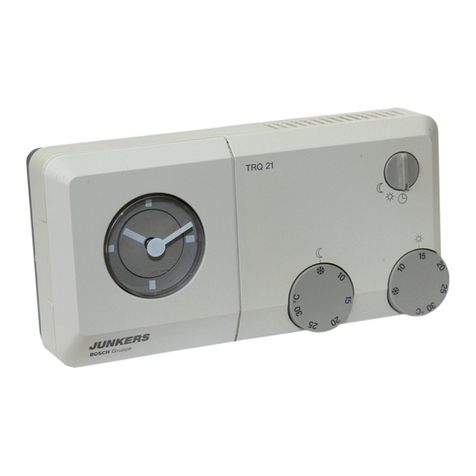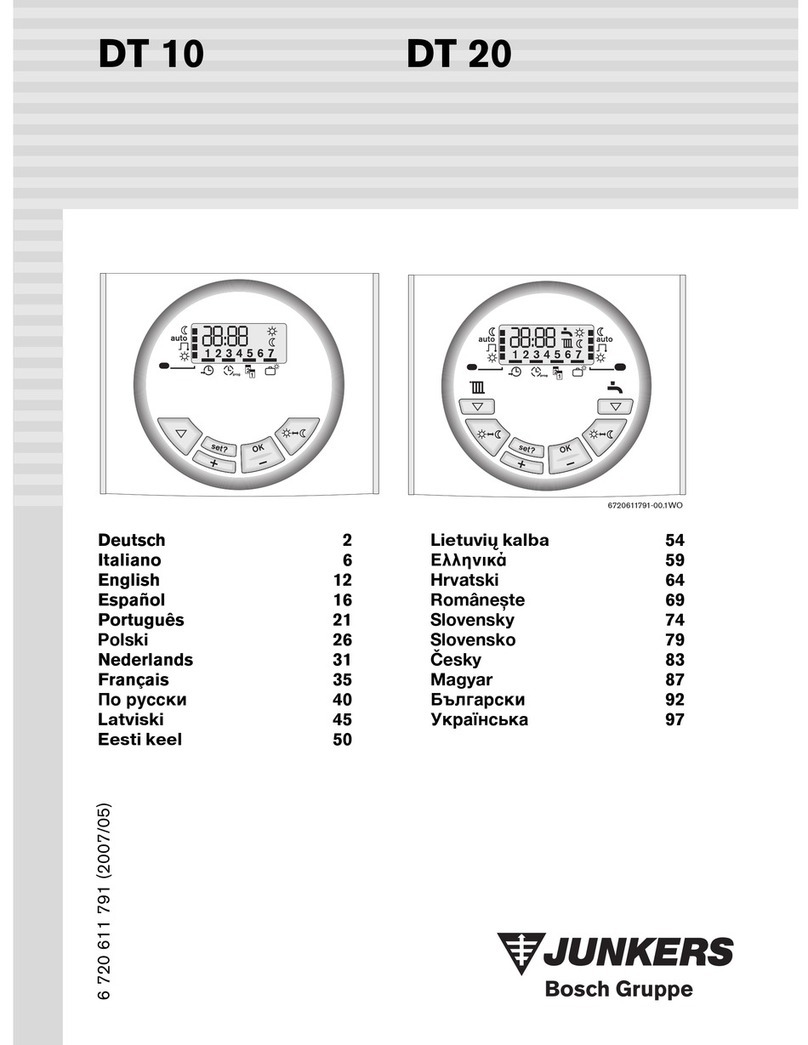4
TR 200
English
1 Safety Instructions ........................................5
2 Application ....................................................5
3 Technical Data .............................................5
4 Mounting ......................................................5
5 Mains Connection ........................................6
6 Operation .....................................................6
• Setting the language.................................12
7 Regulator Malfunction Message .................14
8 General Information ...................................15
9 Elimination of malfunctions ........................16
10 Individual Heating Times ............................17
Po polsku
1 Wskazówki bezpieczeµstwa .......................18
2 Zastosowanie .............................................18
3 Dane techniczne ........................................18
4 Monta† regulatora ......................................18
5 Podƌczenie elektryczne ............................19
6 Obs∆uga ......................................................20
•
Ustawianie j™zyka .....................................25
7 Komunikaty regulatora ...............................27
8 Wskazówki ogólne .....................................28
9 Zak∆ócenia i poszukiwanie przyczyn ..........29
10 Indywidualne czasy ogrzewania .................30
âesky
1 Bezpeãnostní pfiedpisy .............................31
2 PouÏití .......................................................31
3 Technické údaje .......................................31
4 MontáÏ ......................................................31
5 Elektrické pfiipojení ...................................32
6 Obsluha ....................................................32
•
Nastavení jazyka.....................................38
7 Hlá‰ení regulátoru ....................................40
8 V‰eobecné pokyny ...................................41
9 Hledání závad ...........................................42
10 Individuální doby topení ............................43
Slovensky
1 Bezpeãnostné pokyny ..............................44
2 PouÏitie .....................................................44
3 Technické údaje .......................................44
4 MontáÏ ......................................................44
5 Elektrické zapojenie ..................................45
6 Obsluha ....................................................45
•
Nastavenie jazyka ...................................51
7 Hlásenia regulátora ..................................53
8 V‰eobecné pokyny ...................................54
9 Vyhºadávanie ch˘b ...................................55
10 Individuálne ãasy vykurovania ..................56
Magyar
1 Biztonsági tájékoztató ................................ 57
2 A készülék alkalmazási területei ................ 57
3 Mæszaki adatok .......................................... 57
4 Felszerelés ................................................ 57
5 Elektromos csatlakozás ............................. 58
6 Kezelés ...................................................... 59
•
A nyelv beállítása ..................................... 65
7 A szabályozó kijelzése ............................... 67
8 Általános tájékoztató .................................. 68
9 Hibakeresés ............................................... 69
10 Egyedi fætési idœpontok .............................. 70
Slovensko
1 Varnostni napotki .....................................71
2 Uporaba ...................................................71
3 Tehniãni podatki ....................................... 71
4 Namestitev ...............................................71
5 Elektriãni priklop ....................................... 72
6 Upravljanje ...............................................72
•
Izbira jezika.............................................78
7 Regulator - poroãilo .................................. 80
8 Splo‰ni napotki .........................................81
9 Iskanje napak ........................................... 82
10 Tabela vne‰enih ogrevalnih ãasov ...........83
Hrvatski
1 Upute za siguran rad ................................ 84
2 Primjena ...................................................84
3 Tehniãki podaci ........................................84
4 MontaÏa ...................................................84
5 Elektriãni prikljuãak ................................... 85
6 PosluÏivanje .............................................85
•
Namje‰tanje stranog jezika.....................91
7 Dojava regulatora .....................................93
8 Opçi napuci ..............................................94
9 TraÏenje neispravnosti ............................. 95
10 Pojedinaãna vremena grijanja .................. 96
Latviski
1 Dro‰¥bas norÇd¥jumi ................................. 97
2 Lieto‰ana ..................................................97
3 Tehniskie dati ........................................... 97
4 MontÇÏa ...................................................97
5 Elektriskais pieslïgums ............................ 98
6 Apkalpo‰ana ............................................99
•
IestÇd¥t valodu....................................... 104
7 RegulÇtora zi¿ojums ..............................106
8 VispÇr¥gi norÇd¥jumi ............................... 107
9 K∫mju meklï‰ana .................................. 108
10 IndividuÇli apkures laiki ..........................109





























